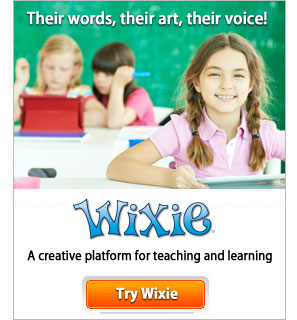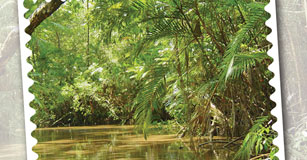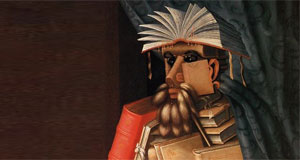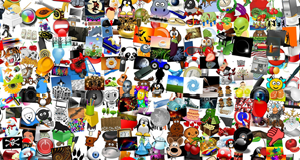My Book
Students will create a mock social network page from the viewpoint of the protagonist or antagonist in a novel they are reading.
Apps: Share®
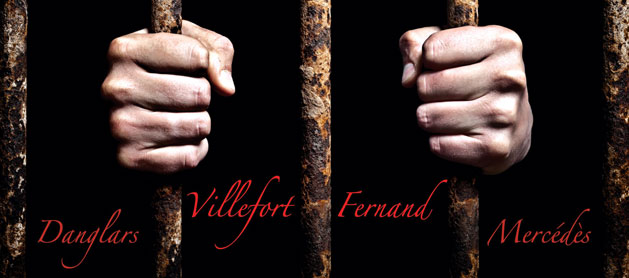
Task
Creating characters for a story requires writers to invent a new person. When we read novels, authors provide details about these characters through descriptive sentences, events that directly involve the character, and what other characters think and say about the main character. In this project, students will take on the viewpoint of a character in a novel they are reading, creating a mock social network page using Share’s MyBook social network template that reflects information they have analyzed for this character.
Engage
Social networking is transforming the way we communicate. This popular medium of expression can engage students in content they are learning in the classroom.
Share with students a few business or professional social network sites. As a class, discuss what differences there may be between a personal social network page versus a professional or business page. Then, discuss how use of text, individual responses, photographs, and videos make an impression on the reader. For example, how do wall posts reflect the relationships between people?
Ask students what they noticed about how network site profiles reflect the business or individual they represent. Prompt students to discuss profile text, pictures, videos, friends, and conversations.
Ask students to reread a novel of their choosing, focusing their attention on the protagonist or antagonist. Have students complete a double-entry journal to take notes on the selected character and events that take place during the story. Remind students to include events that the character is directly involved in as well as what other characters in the novel say about them.
Create
Next, students will need to analyze the character and start to identify the important things to include in their social network page. The more they understand the actions, behavior, and events the character is involved in, the easier it will be to create a profile page from the character’s point of view. Having students complete a character attribute map is a great way to help them gain a deeper understanding of the character.
Once students have completed their notes, have them reflect on ideas that are specific to their characters. For example, a student reading “Kindred” by Octavia Butler might post something on Dana’s wall about how, as a character in Franklin’s group, you’ve missed her in the five years you have been gone. Since students will be commenting on the main character’s status posts from the perspective of another character, prompt them to think about the point of view other characters have about the main character. Print out the pages from the MyBook template in Share to use as a storyboard for the project.
- Page 1 – MyBook Wall
- The heart of a social network profile, this page should include photographs, illustrations, and videos of the main character and their friends, status updates and quotes from the point of view of the main character and replies made by the character’s friends.
- Page 2 – Information Page
- Some of this information may need to be created and should be relevant to the character’s actions, behavior, events, and relationships.
- Page 3 – Pictures and Photographs
- This page should contain images that reflect events important to the main character. Students may choose to illustrate some of the images.
Once students understand how to share analyses of their characters using mock social networking pages, they should begin gathering resources from the Internet, using the illustration tools to create artwork, and searching for clip art in the Share Library.
Once students have completed their preliminary work, they should use the tools in Share to create their character’s MyBook profile.
Share
Have students share their finished MyBook profiles in small groups with other classmates who have read the same book. Compare and contrast MyBook profiles across the class to explore the effectiveness of this medium of communication with writing and supporting illustrations and movies. Share these projects with others in your school Your Librarian or Media Specialist may be interested in posting student work to a station in the media center/library as a way to get other students interested in reading the books that includes these characters.
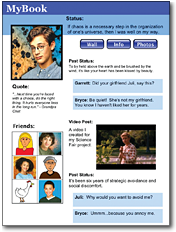
Assessment
The double-entry journals and character attribute maps provide insight to the direction students are heading with their project, helping to avoid wrong turns and ensuring successful completion of the project. Short meetings with each student during the process will help you assess their progress and identify any misconceptions.
The final MyBook profile will help you assess each student’s analysis of the main character and evaluate their ability to communicate ideas using multimedia elements.
Additional Ideas
- Science – Element from the Periodic Table
- Math – Geometric figure
- Social Studies – Historical figure
Resources
EdWeek – Digital Directions: https://bit.ly/c1IDXX
TeacherTube: https://bit.ly/fkgBK5
Kist, William R. The Socially Networked Classroom: Teaching in the New Media Age ISBN-10: 1412967015
Cook, Colleen. Frequently Asked Questions About Social Networking ISBN-10: 1448813298
Standards
Common Core Anchor Standards for English Language Arts - Grade 6-12
Reading Standards
Key Ideas and Detail
3. Analyze how and why individuals, events, and ideas develop and interact over the course of a text.
Craft and Structure
6. Assess how point of view or purpose shapes the content and style of a text.
7. Integrate and evaluate content presented in diverse formats and media, including visually and quantitatively, as well as in words.
Writing
Text Types and Purposes
3. Write narratives to develop real or imagined experiences or events using effective technique, well-chosen details, and well-structured event sequences.
Production and Distribution of Writing
4. Produce clear and coherent writing in which the development, organization, and style are appropriate task, purpose, and audience.
a. interact, collaborate, and publish with peers, experts or others employing a variety of digital environments and media.
b. communicate information and ideas effectively to multiple audiences using a variety of media and formats.
ISTE NETS for Students 2016:
6. Creative Communicator
Students communicate clearly and express themselves creatively for a variety of purposes using the platforms, tools, styles, formats and digital media appropriate to their goals. Students:
a. choose the appropriate platforms and tools for meeting the desired objectives of their creation or communication.
b. create original works or responsibly repurpose or remix digital resources into new creations.
c. communicate complex ideas clearly and effectively by creating or using a variety of digital objects such as visualizations, models or simulations.
d. publish or present content that customizes the message and medium for their intended audiences.



